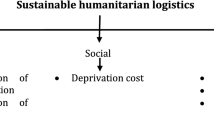Abstract
Consider a rescue plan after a major disaster such as an earthquake, where the objective is to find and rescue as many survivors as possible. The rescue team has to decide where to search for survivors, and as time progress the number of survivors in each location decreases. This problem can be modeled as Discounted Reward TSP on a graph \(G=(V,E)\) where each node \(v\in V\) represents a potential place for searching survivors, and the length of an edge represents the time it takes to travel from one place to another. Each node has an initial prize \(\pi (v)\) (that represents the number of survivors in it) and this prize deteriorates exponentially. Therefore, the prize collected from node \(v\in V\) is \(\pi (v) \lambda ^t\), where \(\lambda \) is the deterioration rate and t is the first time v was visited. The objective is to find a path that maximizes the total prize collected from the nodes of G. We present two different algorithms for Discounted Reward TSP, each improves the previously best known approximation ratio of \(0.1481-\delta \) shown by Blum et al. (SIAM J Comput 37(2):653–670, 2007). Our better algorithm is a \((0.1929-\delta )\)-approximation algorithm.
Similar content being viewed by others
Notes
That is, we scale the original length x to be \(x\cdot \log _2\frac{1}{\lambda }\). If \(\log _2\frac{1}{\lambda }\) cannot be computed exactly, we approximate it within a factor of \(1+\delta \) for sufficiently small value of \(\delta >0\) using a common approximated value for all edges so that the triangle inequality continues to hold. This does not change our results, and in what follows we assume that \(\log _2 \frac{1}{\lambda }\) is computed exactly in polynomial time.
References
Bansal, N., Blum, A., Chawla, S., Meyerson, A.: Approximation algorithms for deadline-TSP and vehicle routing with time-windows. In: Proceedings of the Thirty-Sixth Annual ACM Symposium on Theory of Computing, STOC ’04, pp. 166–174. ACM, New York (2004)
Blum, A., Chawla, S., Karger, D.R., Lane, T., Meyerson, A., Minkoff, M.: Approximation algorithms for orienteering and discounted-reward TSP. SIAM J. Comput. 37(2), 653–670 (2007)
Chaudhuri, K., Godfrey, B., Rao, S., Talwar, K.: Paths, trees, and minimum latency tours. In: Proceedings of the 44th Annual IEEE Symposium on Foundations of Computer Science, 2003, pp. 36–45 (2003)
Chekuri, C., Korula, N., Pál, M.: Improved algorithms for orienteering and related problems. ACM Trans. Algorithms 8(3), 23:1–23:27 (2012)
Goemans, M., Kleinberg, J.: An improved approximation ratio for the minimum latency problem. Math. Program. 82(1–2), 111–124 (1998)
Nagarajan, V., Ravi, R.: The directed orienteering problem. Algorithmica 60(4), 1017–1030 (2011)
Author information
Authors and Affiliations
Corresponding author
Rights and permissions
About this article
Cite this article
Farbstein, B., Levin, A. Discounted Reward TSP. Algorithmica 80, 472–495 (2018). https://doi.org/10.1007/s00453-016-0264-2
Received:
Accepted:
Published:
Issue Date:
DOI: https://doi.org/10.1007/s00453-016-0264-2




